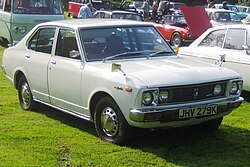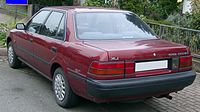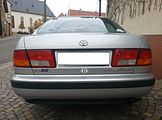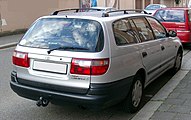Toyota Carina
| Toyota Carina | |
|---|---|
| Production period: | 1970-2001 |
| Class : | Middle class |
| Body versions : | Sedan , hatchback , station wagon , coupe |
| Successor: |
Toyota Avensis Toyota Allion |
Toyota Carina refers to a mid- range model series from the Japanese car manufacturer Toyota , which was sold in numerous generations from the summer of 1970 to mid-2001 and was later replaced by the Toyota Allion and Toyota Avensis series . The very first Carina series provided the basis for the Toyota Celica sports coupé presented in autumn 1970 .
Carina (A12, 1970-1975)
| 1st generation | |
|---|---|
|
Toyota Carina (1970-1975) |
|
| Production period: | 1970-1975 |
| Body versions : | Limousine , coupe |
| Engines: |
Petrol engines : 1.4-2.0 liters (58-107 kW) |
| Length: | 4135 mm |
| Width: | 1570 mm |
| Height: | 1395 mm |
| Wheelbase : | 2425 mm |
| Empty weight : | 960 kg |
The first generation of the Carina was offered in Germany from autumn 1970 to the end of 1975. At the beginning there were only two body variants, a sedan with two or four doors, and two engines, a petrol engine with 58 kW (79 PS) and 63 kW (86 PS). The Carina was available in the DX and ST equipment. The ST was the sporty model of the series. All models had a T40 four-speed gearbox installed, except for vehicles with the ST equipment, which came with five gears as standard.
In 1972 the A12 received a facelift in which, among other things, the tank filler neck was no longer at the rear. In 1973 the first Carina with diesel appeared and in 1975 the Carina got its last facelift before the model change.
In addition to the models on the market in all countries, there was also a two-door hardtop coupe in Japan. The Celica A20 and A35 were also created on the basis of the Carina .
Carina (A14, 1975-1978)
| 2nd generation | |
|---|---|
|
Image does not exist |
|
| Production period: | 1975-1988 |
| Body versions : | Limousine , coupe |
| Engines: |
Petrol engines : 1.4–2.0 liters (55–107 kW) |
| Length: | 4200 mm |
| Width: | 1570 mm |
| Height: | 1395 mm |
| Wheelbase : | 2490 mm |
| Empty weight : | 960 kg |
As with its predecessor, the A14 was available with two and four doors. However, from then on the Carina was only available in Germany (from spring 1976, Japan as early as autumn 1975) with 55 kW (75 hp). The sporty ST version was deleted without replacement. In Germany you had to do without the five-speed gearbox.
However, this generation is not only completely different in terms of appearance and drive. With generation two, the Carina's wheelbase grew. This time the hardtop coupe was only available in Japan.
Carina (A4, 1978-1982)
| 3rd generation | |
|---|---|
|
Toyota Carina (1978-1980) |
|
| Production period: | 1978-1982 |
| Body versions : | Limousine , station wagon |
| Engines: |
Petrol engines : 1.4-2.0 liters (59-99 kW) |
| Length: | 4230-4445 mm |
| Width: | 1630-1645 mm |
| Height: | 1390-1425 mm |
| Wheelbase : | 2495-2500 mm |
| Empty weight : | 945-1010 kg |
The A4 series was introduced in the spring of 1978. For the first time in Europe, the Carina was also available as a five-door station wagon. However, the two-door model, which was now only offered in Japan, was no longer available. However, the diesel was no longer there, the performance of the gasoline engine remained the same in Germany. The equipment got new names, the basic model was simply called Carina, and the Deluxe and GL were added. The Deluxe was only available with an automatic transmission.
In January 1980 came a facelift and in October of the same year the five-speed gearbox was available for all models, including the Deluxe. The basic model was renamed back to DX. Based on the Carina, there was also the Celica A40 and a four-door version with the addition of the name Camry (see also Toyota Camry ), which was new, but only for Japan. Again, the hardtop coupe and the two-door sedan were only sold for Japan.
Carina (A6, 1982-1988)
| 4th generation | |
|---|---|
|
Toyota Carina station wagon (1982–1988) |
|
| Production period: | 1982-1988 |
| Body versions : | Limousine , station wagon |
| Engines: |
Otto engines : 1.45–1.8 liters (61–74 kW) Diesel engine : 1.8 liters (45 kW) |
| Length: | 4385-4470 mm |
| Width: | 1650 mm |
| Height: | 1365-1425 mm |
| Wheelbase : | 2500 mm |
| Empty weight : | 995-1135 kg |
With a construction period of just under two years (early 1982 to autumn 1983), the A6 series was only granted a short life. Compared to the A4 series, the body was significantly smoother and more angular. Of the three configurations, only the DX remained in Germany. This was also available with an automatic transmission at an additional cost.
In Japan the previous series continued to be offered as the Celica A60 and Celica Camry. In the new Carina A6, the body variants and equipment variants were retained. The hardtop coupe has now also been sold in Europe, but not in Germany. The station wagon was also available in Japan with the heavy-duty chassis suitable for heavy loads.
Although the successor model was presented at the end of 1983, the last rear-wheel drive model in the Carina series was manufactured in certain versions until 1988.
Carina (T150 / T160, 1984-1988)
| 5th generation | |
|---|---|
|
Toyota Carina (1984–1988) |
|
| Production period: | 1984-1988 |
| Body versions : | Sedan , hatchback , station wagon |
| Engines: |
Otto engines : 1.45–2.0 liters (61–101 kW) Diesel engines : 1.8–2.0 liters (45–65 kW) |
| Length: | 4350 mm |
| Width: | 1670 mm |
| Height: | 1320-1365 mm |
| Wheelbase : | 2515 mm |
| Empty weight : | 950 kg |
From the beginning of 1984, the Carina shared the front-wheel drive platform with the Corona , but was still designed to be sportier than this.
Carina II (T15, 1984-1987)
For the European market, the Carina was replaced by the Carina II in spring 1984. In contrast to the Carina, this is identical to the Toyota Corona for the Japanese market. The station wagon was dropped, instead a five-door liftback appeared (hatchback with a large tailgate, rear seats that could be individually folded down and tilted). The engine range in Germany increased to four variants, the most powerful model of which had 75 kW (101 hp). The smallest model (1.6l) had 63 kW (86 PS). In addition to the DX there were the GL, XL, SX and GLi. The liftback got the automatic transmission.
In December 1985 came a facelift. There were new engines, including a new two-liter diesel engine, which was the largest displacement engine in Carina history up to that point.
In 1986, Toyota supplied the 1.6-liter engines with catalytic converters. In 1987 a further 1.6-liter engine was added to the range, with the 1.8-liter engine disappearing.
Carina ED ST160
Carina (T170 / T180, 1988-1992)
| 6th generation | |
|---|---|
|
Toyota Carina II Liftback (1988-1992) |
|
| Production period: | 1988-1992 |
| Body versions : | Sedan , hatchback , station wagon |
| Engines: |
Otto engines : 1.45–2.0 liters (61–89 kW) Diesel engine : 2.0 liters (51–65 kW) |
| Length: | 4380 mm |
| Width: | 1690 mm |
| Height: | 1370 mm |
| Wheelbase : | 2525 mm |
| Empty weight : | 1060 kg |
Carina II (T17, 1988-1992)
At the beginning of 1988 the Carina of the T17 series came onto the market. Initially, however, there was no eight-valve two-liter engine; earlier customers of this engine were supplied with a new 89 kW (121 hp) 2.0 l 16V engine. The equipment was limited to two variants, customers were only served with XL (1.6) and GL (1.6, 2.0). The eight-valve two-liter engine that followed was again the only model to have the automatic transmission, with the exception of the station wagon. In Germany, the station wagon was only offered as XL (i) equipment.
In Japan there were two tracks again, with the Corona (in this case a variant of the European Carina) and the Carina. Both had a large number of equipment, it stayed with the usual engines, thus also with the diesel.
In 1989 the already mentioned two-liter 8V engine appeared, which was even equipped with a catalytic converter. Five months later, in September 1989, Toyota decided to also install the catalytic converter in the 1.6-liter engines with 66 kW (90 hp). At the same time, the Carina 2000, a sporty liftback, came out as a special model.
In March 1990 the Carina T17 got a facelift and the catalytic converter continued to soar. The 1.6 l 16V engine with 66 kW was still supplied with gasoline by an electronically controlled carburetor. The 72 kW (98 PS) engine that followed was a further development of this almost indestructible engine (4A-FE) and a minor revolution. This engine was the first so-called lean-burn engine in the Carina and was equipped with a multipoint fuel injection . With a consumption-oriented driving style, a consumption of 5.5 to 6.0 l per 100 km can be achieved, the full load consumption, however, is more typical for this class. The 66 kW version was thus omitted.
In addition to the engines mentioned, there was a 2.0 l diesel engine without turbocharging with 51 kW (72 hp). Mileage of 500,000 km and more is more the rule than the exception. Gray imports also brought such cars onto German roads.
Carina (T190, 1992-1997)
| 7th generation | |
|---|---|
|
Toyota Carina (1992-1997) |
|
| Production period: | 1992-1997 |
| Body versions : | Sedan , hatchback , station wagon |
| Engines: |
Gasoline engines : 1.6–2.0 liters (79–129 kW) Diesel engine : 2.0 liters (54–61 kW) |
| Length: | 4450 mm |
| Width: | 1695 mm |
| Height: | 1400 mm |
| Wheelbase : | 2580 mm |
| Empty weight : | 1150 kg |
Carina E (T19, 1992-1997)
The Carina E (E for Europe) or Carina T19 was specially developed for the European market and production was relocated from Japan to Burnaston ( United Kingdom ) from December 1992 . Technically, however, it largely corresponds to the Corona. Thanks to a lean-burn engine, the vehicle achieves a gasoline consumption of 6.5 liters / 100 km (notchback and hatchback with 1.6 l or 1.8 l petrol engine , 79 kW / 107 PS) is below the consumption value of many small cars. The body has become significantly larger compared to the Carina II. The vehicle was built in three body styles ( notchback , hatchback and station wagon ); In addition to various petrol engines, a 2.0-liter diesel engine with 61 kW (83 hp) was also offered from 1996 , which was mainly sold in Belgium and Austria.
In mid-1996, in addition to a model upgrade , passive safety ( airbags , side impact protection, etc.) was also improved .
In September 1997 production of the Carina E.
The Carina E was available with the following engines:
- Gasoline engine
- 1.6 liters with 79 kW / 107 PS lean mix (4A-FE)
- 1.6 liters with 73 kW / 99 PS lean mix ( facelift from 1997) (4A-FE)
- 1.8 liters with 79 kW / 107 PS lean mix (from 1995) (7A-FE)
- 2.0 liters with 98 kW / 133 PS (3S-FE)
- 2.0 liters with 93 kW / 126 PS ( facelift from 1996) (3S-FE)
- 2.0 liters with 116 kW / 158 PS GTi (3S-GE)
- 2.0 liter with 129 kW / 175 PS GTi ( facelift from 1994) (3S-GE)
- diesel
- 2.0 liters with 54 kW / 73 PS (2C)
- 2.0 liter with 61 kW / 83 PS turbodiesel ( facelift from 1996) (2C-T)
Carina E GTi
The GTi version of the Carina E was only offered as a hatchback variant. Visually, the GTi was distinguished by a rear spoiler and a double-pipe exhaust system. The most powerful model of the Carina E relied on the engine range of the Celica , due to the increased power, the Toyota received disc brakes on the front and rear axles . A special technical feature was the Super Strut chassis, which was first offered in Europe in the GTi. The chassis can be found in later models of the Celica , as well as in its rally versions.
reliability
In the statistics from TÜV and ADAC , the Carina E was certified to be one of the vehicles with the least defects and breakdowns.
Based on the Carina E, a van version called Toyota Picnic was also built between summer 1996 and summer 2001 .
Carina (T210, 1996-2001)
| 8th generation | |
|---|---|
|
Toyota Carina (1996-2001) |
|
| Production period: | 1996-2001 |
| Body versions : | Limousine , station wagon |
| Engines: |
Otto engines : 1.45–2.2 liters (? –121 kW) Diesel engines : 2.0–2.2 liters (61–? KW) |
| Length: | 4450 mm |
| Width: | 1695 mm |
| Height: | 1395 mm |
| Wheelbase : | 2580 mm |
| Empty weight : | 1110 kg |
The last generation of the Carina was introduced in mid-1996. It was identical to the Corona Premio and was replaced by the Toyota Allion in summer 2001 .
literature
- J. Kuch, Toyota since 1936 , 2004, ISBN 3-613-02213-3
- Oldtimer-Markt magazine , issue 12/1993 and 10/2003 (both for the TA12 model, year of construction 1970–75)
- Magazine auto motor sport , No. 13/1992, 9/1993 and 10/1996 (all to the model T19, built in 1992-98)
Web links
Individual evidence
- ↑ Article from the Süddeutsche Zeitung on Carina E
- ↑ Toyota Super Strut Suspension System (Eng.)
- ↑ functioning and models with Super Strut suspension (Engl.)















